Collaborative innovation, in a general sense, refers to any situation where a group of people, typically of different backgrounds or expertise levels, work together on new ideas, such as for new products or processes. Many discussions of collaborative innovation use the open source movement (and particularly the development of software like Linux or Firefox) as an example: developers and designers from all over the world contribute and collaborate to make popular and powerful software.
Those are indeed great examples of global collaborative innovation, and the business community would be wise to learn a lot from them.
But what we’re concerned about here, and where our experience lies, is how an individual organization — such as a business, university, or government office — can create sustained collaborative innovation among their employees.
For over a decade, we’ve consulted with large organizations like Fortune 500 companies and government agencies, helping them implement tools and processes to foster greater collaboration and innovation. And we’ve seen that most of them want to do collaborative innovation; they want a “culture of innovation” in order to fully utilize the creative potential of their entire workforce. But they’re often met with challenges.
Why?
In our experience, it’s because they don’t have the necessary systems and processes to get employee involvement throughout the entire innovation process. They may have an innovation team or an entire innovation department; they may have quarterly goals around new ideas or even some idea collection tools they use — but in the end, very few employees, outside of managers in one or two departments, are consistently participating in new idea capture, cultivation, validation, and implementation. So, sadly, “collaborative innovation” in the vast majority of these organizations becomes little more than a buzzword.
In this article, we’re going to detail what systems and processes you need to actually implement a sustained, effective collaborative innovation process inside your organization. This means achieving a situation where a large and diverse swath of employees consistently participate in the entire innovation process (not just occasionally submitting ideas).
You can schedule a free consultation with us to learn more about our approach and solutions.
Why Attempts at Collaborative Innovation Often Fail
Innovation is a multi-step process, not just idea collection. Yet, in many organizations, collaborative innovation seems to entail simply asking employees for ideas, and that’s it.
There’s nothing wrong with asking for ideas on a given topic, but as we’ve written about before, true innovation management requires an intentional process of assessing and validating ideas to nurture them through implementation.
That means true collaborative innovation involves collaboration at every step of the innovation process. If you simply ask employees to submit ideas into a web form or an ideas@company.com email address, and then a small group of innovation managers takes things from there, you’re not really collaborating on innovation — you’re just crowdsourcing ideas.
The ‘Digital Suggestion Box’ Isn’t Collaborative Innovation
In our experience working with dozens of (big and small) organizations, this method of having a “digital suggestion box” is extremely common. Employees are occasionally asked to submit ideas, and a small team or department manages the rest. As a result:
Most ideas aren’t even evaluated. These small teams within an innovation department simply don’t have the bandwidth to evaluate all ideas as they come in.
Employees have no idea what happens to the ideas they submit.
The feedback network is extremely limited and employees outside of the innovation department cannot contribute to the idea refinement and assessment process.
As a result, employees have no incentive to continue participating or submitting ideas, and the innovation team has a harder time getting others involved in future projects. Even more detrimental — this prevents innovation teams from being able to build and maintain a true culture or community of innovation.
There Is Often No System or Process After Idea Collection
Exacerbating this “digital suggestion box” approach is the fact that many innovation programs don’t have a set process for what happens after ideas are collected. They collect ideas (usually via a digital suggestion box), and then management or employees in the innovation department review however many they can. Ideas that look promising are perhaps sent to subject matter experts for their opinion, and those ideas are hopefully assessed or acted upon — or just used as feedback or input to the relevant department. The most promising ideas are perhaps given a dedicated team to work on.
The point is, the idea assessment, validation, and implementation processes are often (1) ad hoc and (2) not transparent. Original submitters of the idea have no idea what’s happened to it, much less the wider organization.
The Collaborative Innovation Process — and Why Having the Right Software Is Important
Below, we review the more detailed steps of a healthy collaborative innovation system — the process involves two main steps:
First, you need a system for gathering and refining ideas. This means encouraging everyone in your organization to contribute to ideation and knowledge sharing. It's about creating a space where ideas can be shared, viewed, discussed, and improved upon by multiple user groups in your organization.
Next, you assess and test these ideas. This is where you evaluate their potential, put them through various stages of development, determine their feasibility and impact (your ability to create new value from them), and plan implementation steps.
The key is that there needs to be full employee participation and transparency in each of these steps (obviously respecting sensitive information or confidentiality concerns).
In order to enable true collaboration at each of these steps, you need the right tools and systems. But many teams find that the standard suite of office software — like email, online survey tools, project management software, or even document collaboration software (e.g., SharePoint) — aren’t enough.
We built our innovation management platform, InnovationCast, to specifically solve the shortcomings of these other systems. Below, we illustrate the steps of a healthy collaborative innovation process using features of InnovationCast as an example.
The Steps of a Thriving Collaborative Innovation Process
Step 1: Collect and Refine Ideas
Soliciting ideas from the community via an intake form is a time-honored tradition, but has two main shortcomings:
Employees outside of the innovation department aren’t usually “in the know” about current challenges or initiatives, so they submit ideas about any topic instead of working together to solve pointed problems.
Usually, only a select group of people see the submitted ideas, leaving employees in the dark about the status of their ideas. Which, as mentioned above, hurts employee motivation and involvement.
Here’s how InnovationCast solves these issues.
Shaping Ideas with Challenges
Besides simply proposing ideas, we add the possibility of creating Challenges. A Challenge is a time-bound solicitation for innovative ideas, channeling creativity and problem-solving towards specific organizational goals.
An employee or manager posts a Challenge for the community to solve by identifying an area for improvement and soliciting feedback. The community adds their comments and suggestions to the idea, either refining or discarding it — so the innovation team can harness users’ collective intelligence and work towards a common goal.
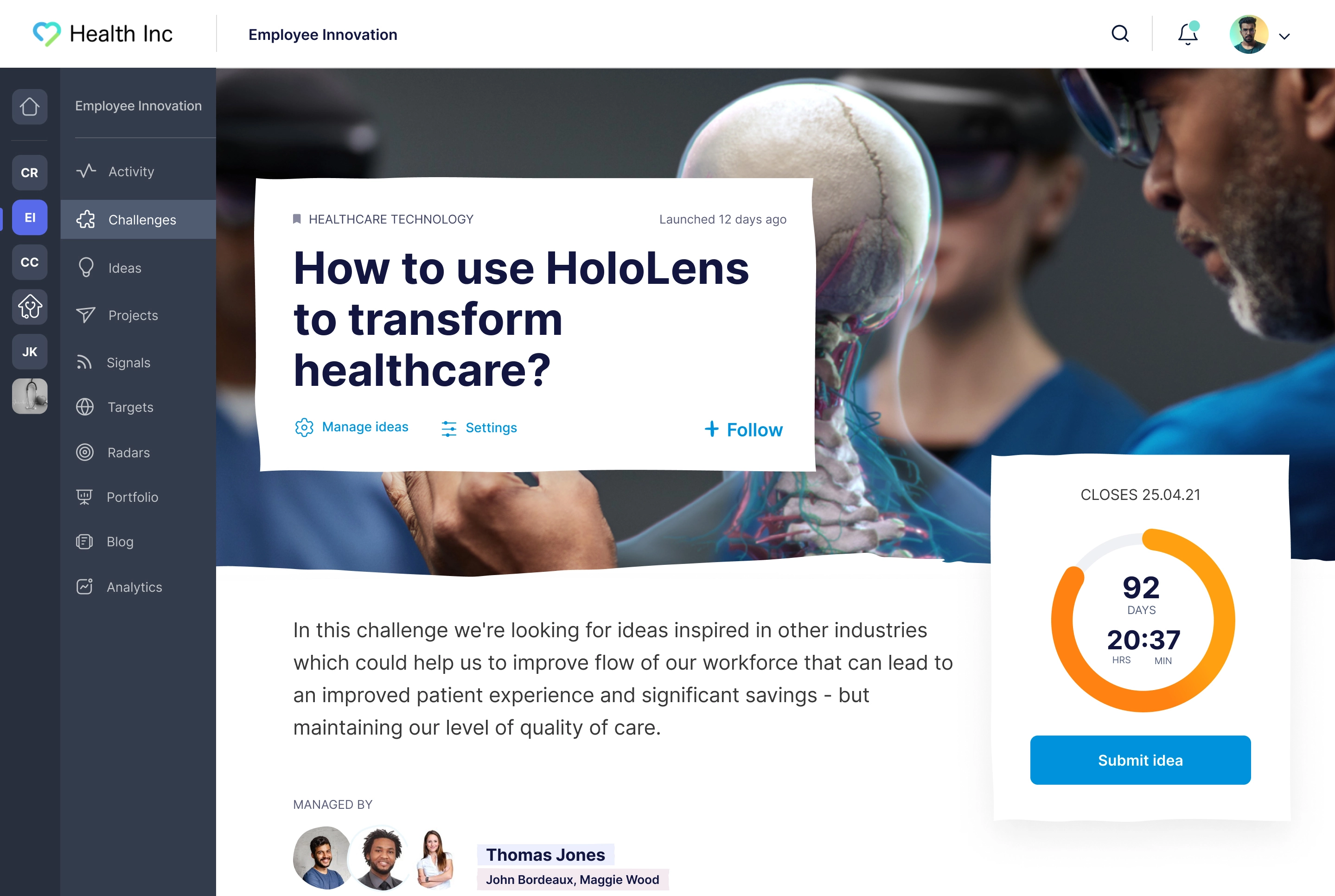
Overall, we've found that Challenges work better than just having an open invitation for ideas because they:
Focus on what's important. When a company has a specific goal, they set up a Challenge that corresponds to the goal.
Offer better context of a problem. The person creating the Challenge can add images, videos, and detailed descriptions as necessary.
Have a deadline. This adds urgency to sharing ideas that “always on” calls for ideas don’t.
Are viewed by the community. In contrast to the traditional process, where employees submit an idea and then move away (waiting for a manager to either approve or disapprove it), the community provides actionable feedback to help authors improve their ideas.
Idea Visibility and Interaction
InnovationCast displays an Activity feed of ideas from the entire community (including relevant comments, suggestions, and revisions) for users when they log in; this level of transparency creates a collaborative ecosystem for users to share, discuss, and develop ideas openly.

Note: Users can also submit and iterate on private ideas when intellectual property is a concern or users want to limit feedback to a few others. Ideas aren’t required to be shared publicly.
We’ve also added social design buttons like “Follow” and “Share” (highlighted below) that keep users in the loop and support your collaborative innovation network — managers don’t have to send updates manually.
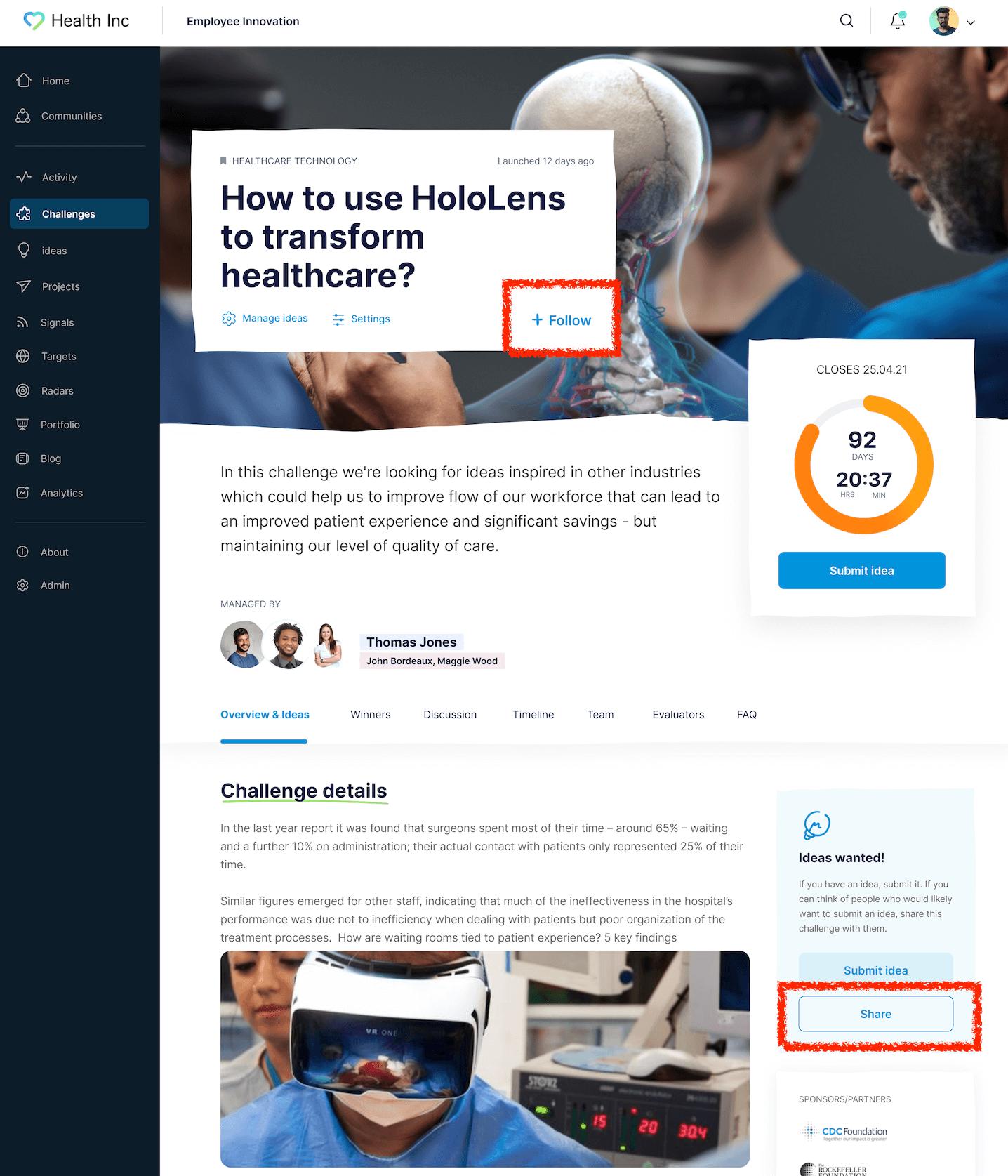
Vetting Ideas with Productive Feedback
One limitation of typical idea collection software is that they don’t have comprehensive feedback features; users can “like” or “thumbs up” an idea without commenting on why they like the idea — and these details are crucial for iteration.
We overcome this in our voting feature: users rate an idea (i.e., “Looks great,” “I have questions,” and “Needs work.”) and must explain why they voted that way.

This is especially useful for those who may not have ideas of their own, but have constructive feedback on others’ ideas; it’s also valuable in solving more complex problems and fine-tuning ideas before assessment.
Idea authors or Challenge creators can highlight especially valuable feedback as a “Significant Contribution,” fostering an environment where users are motivated to offer detailed and constructive feedback. This not only acknowledges their input but also encourages repeat participation by visibly recognizing and acknowledging their meaningful contributions.

These are just a few of the features provided by InnovationCast to turn one-sided idea-collection into a community-driven, collaborative approach that encourages constructive feedback.
Step 2: Assess and Validate Ideas
Collecting and vetting ideas in a collaborative environment is the first step to implementing them. The next step — assessment and validation — involves evaluating ideas against specific criteria to determine their potential viability and impact.
This process is much more than just gathering feedback. It's also about analyzing ideas based on feasibility, market potential, alignment with company goals, business opportunities, and resource requirements.
This is where a lot of organizations have an opportunity to follow a collaborative innovation program but get it wrong:
Many ideas remain underutilized because they get submitted to a database and then idle away, often forgotten. This represents a waste of organizational creativity and potential.
An idea may be selected for validation but is taken offline for further development. This leaves the original idea contributors in the dark about the progress or fate of their ideas. This discourages further contribution because they can’t see the fruits of their work.
Different departments might have their own methods for evaluating and validating ideas. For instance, the IT department may prioritize ideas based on technological feasibility, while the customer service team might prioritize based on customer feedback. Without a platform that can support diverse innovation processes and workflows, aligning these different evaluation criteria becomes challenging.
This disjointed and inconsistent handling of innovation processes across different departments, coupled with an overall lack of transparency, is one of the chief challenges we set out to overcome when we built InnovationCast.
A Collaborative Roadmap for Idea Development
InnovationCast centralizes ideas for the whole organization on one platform and provides workflows to introduce a systematic, phased approach to your innovation strategy.
This allows for the entire lifecycle of an idea — from submission to implementation — to be tracked and managed within the system. It makes the process transparent and clear, so that stakeholders can see the evolution of an idea, its current status, and the steps taken at each phase.
Below is an example of a product innovation workflow with six stages:
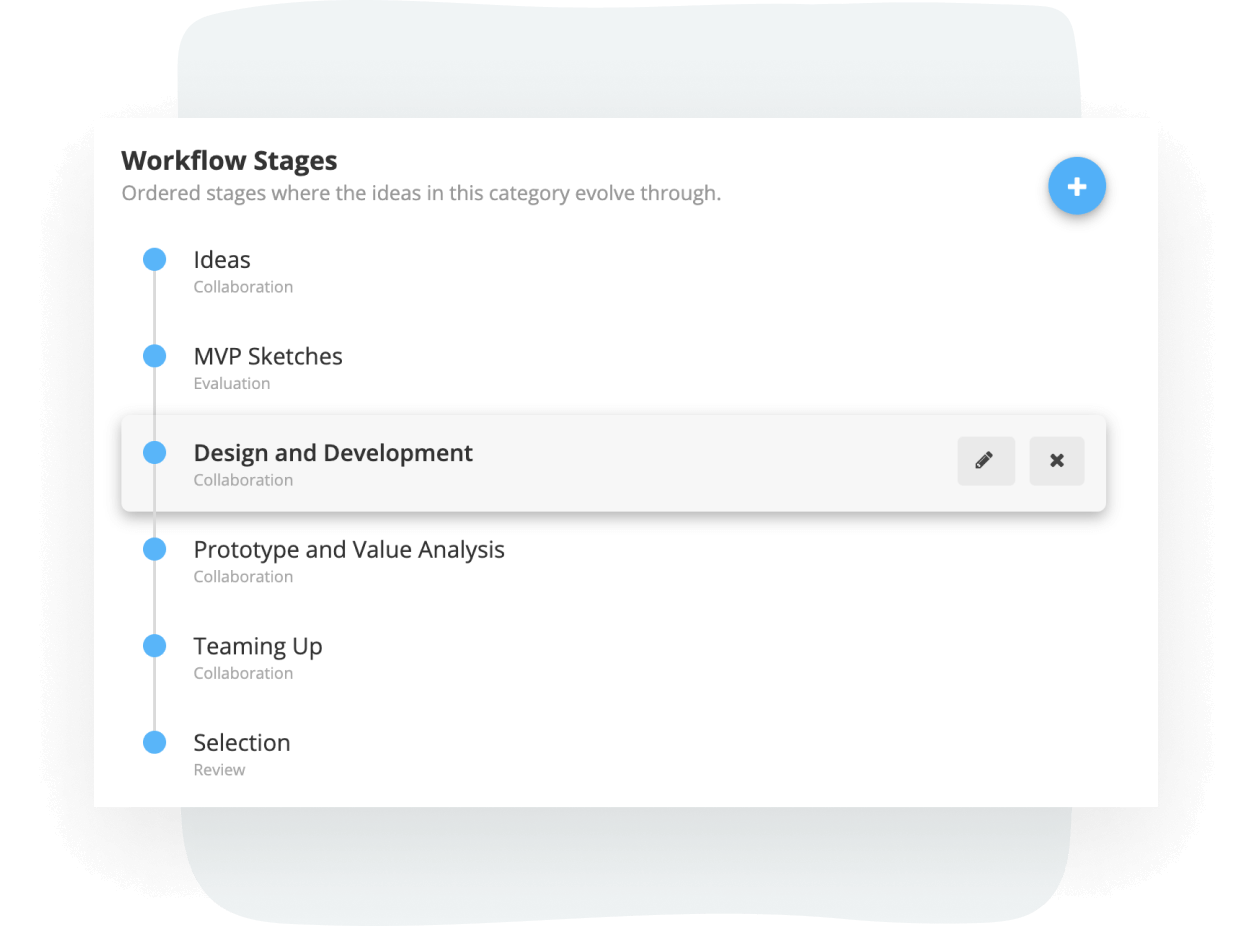
You can configure each stage to notify specific user groups, require users to answer questions such as risks and assumptions, or specify other conditions to be met before moving to the next stage.
In the Design and Development stage, the design team might upload a file containing a high-fidelity mockup for approval by the lead designer, after which both the project and engineering team managers would be automatically notified. The process would then move into development, with the engineering team taking the lead to fulfill the necessary criteria to advance the idea to the Prototype stage.
Each workflow stage is highly customizable, allowing you to specify which questions must be answered, which hypotheses must be validated with experiments, and which stakeholders need to be involved — all in alignment with your innovation process. This is in contrast to the usual homegrown methods, using spreadsheets or email threads, where there’s often a single thread of replies or comments throughout the entire idea lifecycle.
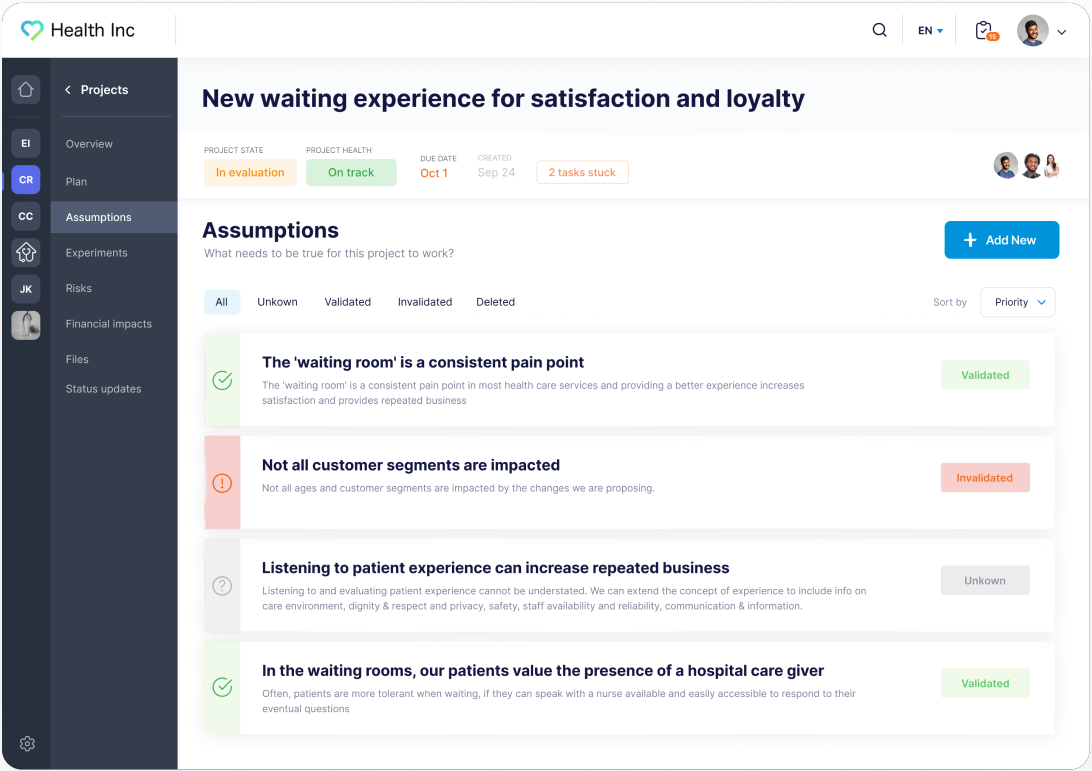
Also, importantly, InnovationCast allows the use of multiple different idea assessment workflows for different categories of ideas. This is a small but important detail about creating a successful collaborative innovation process that many innovation management tools overlook.
Most software only supports a single workflow (or they require lengthy development work to create custom workflows) — but this is not a natural way that ideas are nurtured in large organizations. Different types of ideas need different assessment steps. The steps required for new product development differ from those to implement a new retail customer experience idea.
If your system or software only supports a single set of idea assessment stages, it isn’t going to work well, and people will be far more likely to “take ideas offline,” which as we said above, kills transparency and, thus, collaboration.
Collaborative Project Management
Unlike standard project management tools (like Jira or Asana) that lack integrated idea lifecycle management, InnovationCast offers project management features that are geared towards collaboratively developing and validating ideas.
You create task cards for innovation projects and assign these to team members. InnovationCast’s project dashboard shows the overall status of your projects and tasks:
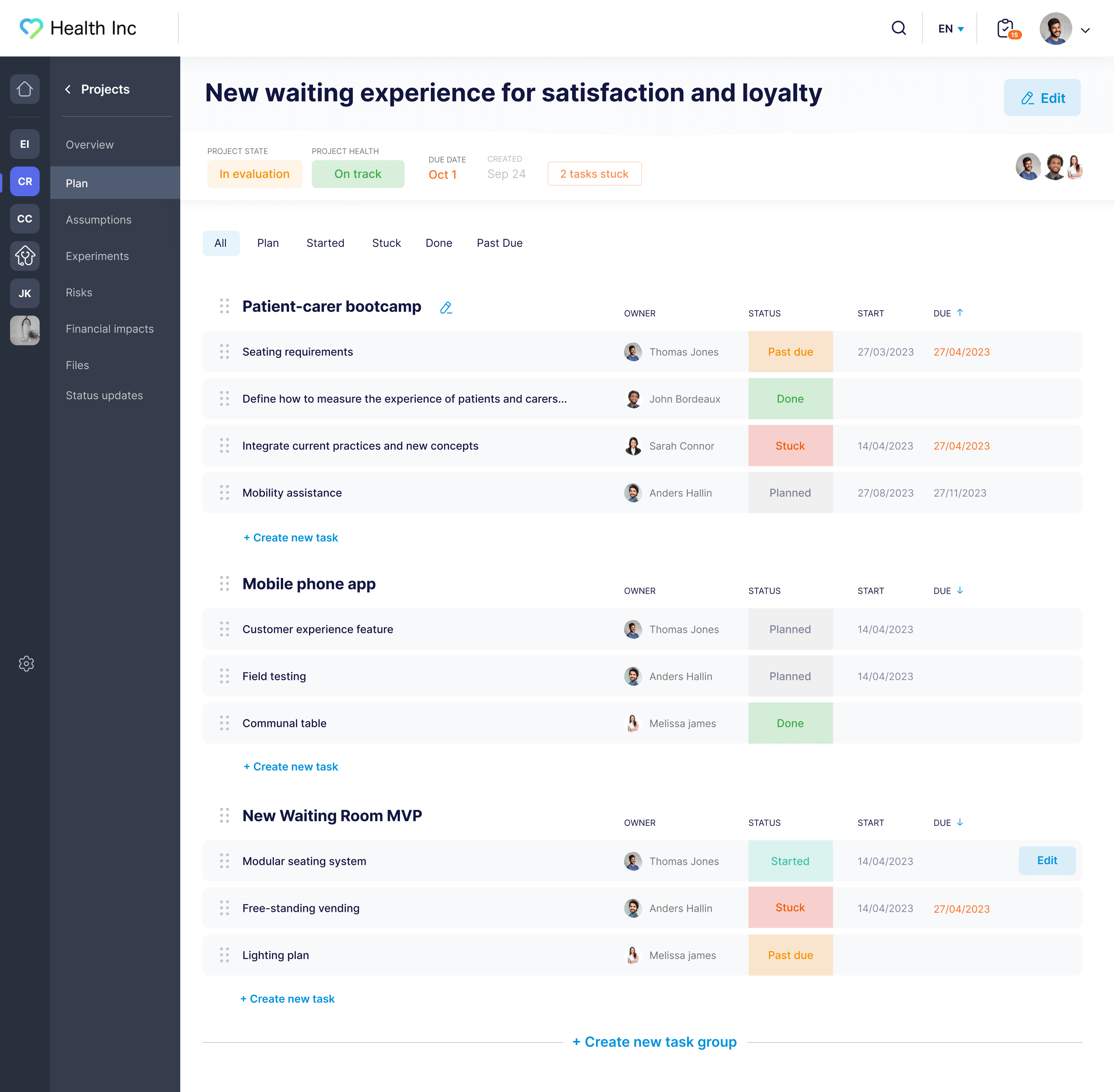
You can zoom in on a particular project to see details regarding the progress of individual tasks, assumptions, experiments, and more.
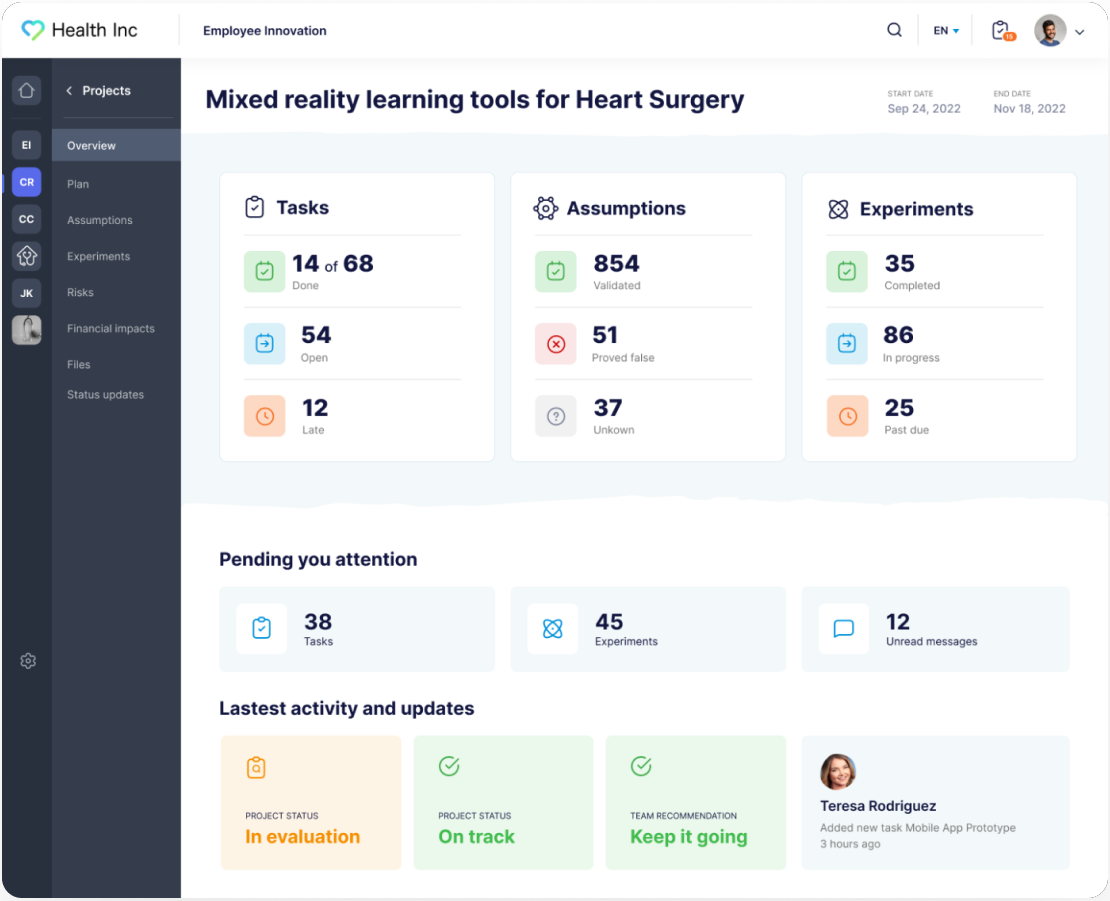
We designed these views for innovation projects, specifically, since standard project management tools are more focused on task execution rather than on prioritizing ideas based on feasibility, potential impact, and alignment with strategic goals.
Examples of Collaborative Innovation
The following case studies show how we helped introduce collaborative innovation at two large organizations.
How DHL Harnesses Employee Ideas
Logistics company DHL needed a way to harness the collective brain power and idea potential of a large workforce that’s spread across geographies and functions.
Its IT services team alone numbers over 5,000 professionals, supporting business units worldwide. The IT team has a wealth of experience and know-how, but fostering an environment where ideas can be discussed, evaluated, and realized collaboratively proved challenging — despite having extensive systems for managing logistical operations.
The end result was that many good ideas and potential solutions remained untapped and locked away in regional and functional silos. To overcome this, DHL needed a unified platform to share and implement ideas collectively. For this, they partnered with InnovationCast to launch IdeaHub, an internally branded platform that embodies their innovation process.
Its collaborative innovation workflow includes four main phases:
Discussion: where ideas are submitted or co-created by employees using InnovationCast’s feedback-based voting.
Evaluation: where assigned idea owners assess the idea via a process tailored to the exact steps and criteria they need.
Refinement: where the author and owner improve the idea, if needed.
Idea implementation
For example, DHL’s workforce contributed to IdeaHub during the COVID-19 pandemic to quickly adapt and rethink work practices to improve the employee experience.
IdeaHub’s results speak for themselves:
New ideas now take 4 weeks from launch to implementation.
The number of submitted ideas has jumped by 67%.
14% of all ideas have been fully implemented in the last two years.
Novo Nordisk's Approach to Innovation Projects
Novo Nordisk, a multinational pharmaceutical company with over 50,000 employees, distributed in 80 offices worldwide, launched an initiative to innovate their operations. However, the absence of a central platform to manage ideas and innovation projects created a lack of transparency that contributed to challenges in reporting and tracking the progress of these projects.
The company was on the lookout for a system that could not only manage innovation projects but also encourage teamwork and idea-sharing among its thousands of employees.
Together with InnovationCast, the company launched Spark, an innovation portfolio management platform that connects employees in different regions and encourages their collaboration by displaying their profiles and job titles via InnovationCast’s Single Sign-On (SSO). Spark also integrated InnovationCast’s Power BI connector to create dashboards that displayed data in a useful way for portfolio managers.

This allowed managers to browse projects by therapy area, status, and other criteria.
Spark’s greatest impact was bringing much-needed transparency and shared awareness about ongoing innovation projects to a large part of the business. As a result of introducing InnovationCast:
Hundreds of innovation projects are managed today.
10+ pharmaceutical product lifecycles are impacted.
Decision-making has greatly improved with more accurate portfolio reporting.
Ready to Embrace Company-Wide Innovation?
When it comes to innovation projects, getting everyone on the same page without the right systems and tools can be overwhelming.
InnovationCast is a collaborative innovation platform that lets you manage the entire process of turning ideas into actionable projects. Trusted by industry leaders like DHL and Novo Nordisk, our software encourages collaborative work and empowers teams to see the impact of their ideas and contributions.
To see how InnovationCast helps you build a true culture of collaborative innovation, schedule a free demo & consultation.

